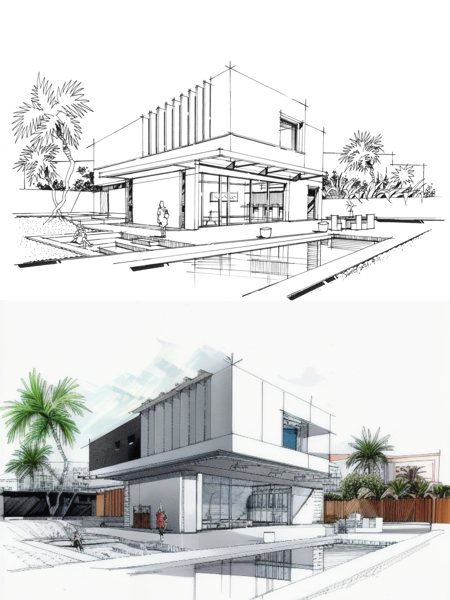Recognizing the Collaborative Process Between Designers and Engineers in Modern Building And Construction Projects
The joint procedure in between architects and designers is important in contemporary building and construction jobs, as it integrates layout intent with engineering expediency. Exploring these characteristics discloses understandings that could significantly affect job end results and overall market requirements.
The Relevance of Collaboration
The joint harmony in between designers and engineers is necessary for the effective realization of any construction job. This collaboration combines distinctive competence and viewpoints, making it possible for the assimilation of cutting-edge design with sensible engineering services. By functioning with each other, engineers and designers can guarantee that a project not just meets visual and functional needs yet also sticks to security, sustainability, and monetary restrictions.
Collaboration promotes a shared vision, helping with the positioning of objectives and assumptions from the start. This alignment is crucial in attending to possible difficulties and mitigating risks that could emerge during the task lifecycle. A collective strategy allows for the efficient appropriation of sources, optimizing both time and expense.
The relevance of cooperation reaches the iterative process of design and construction, where comments from designers can educate building decisions, causing more feasible and lasting styles. Alternatively, architects can influence engineers to believe artistically concerning just how to achieve structural integrity without compromising imaginative intent. Inevitably, the collective relationship between architects and designers is not just useful; it is essential to the creation of top quality, functional, and innovative developed settings that fulfill the demands of culture.
Interaction Strategies and Devices
Effective interaction strategies and devices are essential for cultivating collaboration between designers and designers throughout the job lifecycle. Establishing clear channels of communication is important to guarantee that all group members are aligned with project objectives, timelines, and responsibilities. Routine meetings, both in-person and digital, provide possibilities for stakeholders to go over progress, address concerns, and make informed decisions.

In addition, adopting collaborative communication tools, such as Slack or Microsoft Teams, permits immediate messaging, documents sharing, and continuous conversations, promoting an extra active response to arising issues. Document administration systems additionally play an important role in organizing task documentation, guaranteeing that all staff member have access to the most recent information.
Shared Objectives and Project Vision
A combined task vision functions as the foundation for effective partnership in between engineers and engineers (cda architects). This shared vision not only aligns the efforts of both parties but additionally develops a common framework for decision-making throughout the task's lifecycle. By articulating clear objectives, stakeholders can efficiently navigate the intricacies of contemporary building jobs, making sure that both aesthetic and practical demands are satisfied
Developing shared goals includes open discussion and a complete understanding of each self-control's payments. Designers generally concentrate on layout intent, spatial connections, and user experience, while designers stress architectural integrity, systems functionality, and conformity with regulations. When these perspectives are straightened, the outcome is a cohesive job that complies with both creative aspirations and technical feasibility.
Furthermore, a distinct job vision fosters liability amongst team participants, encouraging each participant to take possession of their function in accomplishing the wanted outcome. Routine check-ins and joint workshops can better enhance this commitment, permitting adjustments to be made as the job progresses. Inevitably, a common vision not only improves synergy yet additionally raises the top quality of the final deliverable, resulting in effective job conclusion.
The Role of Innovation
Leveraging innovation has come to be essential in improving partnership in between engineers and engineers. The integration of resource sophisticated software application tools facilitates real-time interaction and details sharing, enabling groups to function more efficiently and successfully. Structure Details Modeling (BIM) attracts attention as a critical modern technology, enabling both engineers and designers to produce comprehensive 3D versions that encapsulate layout intent and architectural honesty. This common visual representation lessens misunderstandings and streamlines the decision-making process.
Additionally, cloud-based systems make it possible for seamless partnership, allowing project stakeholders to access and upgrade task data from anywhere. This cultivates a culture of transparency and accountability, as adjustments can be tracked and assessed in real-time. Furthermore, mobile applications additional boost communication, giving on-site teams with immediate access to project specifications and updates.
Emerging innovations such as expert system and artificial intelligence are likewise beginning to play a duty in anticipating analysis, helping teams recognize possible concerns prior to they occur. Inevitably, the function of innovation in architecture-engineering cooperation not only boosts workflow performances but also boosts advancement, leading to more effective job outcomes. By welcoming these technological innovations, architects and designers can make sure a much more natural and effective joint process throughout the building and construction lifecycle.
Instance Research Studies in Effective Partnerships
Various case studies highlight the extensive impact of reliable collaborations between engineers and engineers on task end view website results. One notable instance is the collaboration on the High Line in New York City City, where landscape engineers, engineers, and metropolitan organizers worked with each other to transform a deserted railway into a vibrant public park. This multidisciplinary method not just improved the aesthetic high quality however additionally made certain architectural safety and environmental sustainability.

The Burj Khalifa in Dubai additionally shows the significance of collaborative initiatives - cda architects. The combination of style and design competence made it possible for the job team to achieve unmatched heights while adhering to security policies and visual vision
These instances underscore the significance of communication, count on, and shared objectives. In today's intricate construction environment, such collaborations are essential to browsing difficulties and providing projects that meet both useful and visionary goals.
Verdict
In verdict, the collaboration between engineers and engineers is necessary for the success of modern building jobs. Reliable communication methods, a common project vision, and the integration of innovative technologies are company website essential parts that promote this partnership.